“She’s going to try and choke her!” a commentator yells as MMA fighter Xiong Jingnan, or ‘The Panda,’ jumps onto Singaporean Tiffany Teo’s back.
It’s the first round of the inaugural ONE Women’s Strawweight Championship. Two women battle barefoot inside a round cage to the cheers of a rapturous crowd in Jakarta, Indonesia, and the unheard cries from streamers watching online.
The Panda slips off but manages to send a kick to her challenger’s face moments later. Xiong is lightning fast, and by the end of the third round, her opponent looks shattered. “Teo’s face is a mess,” the commentator observes.
Shortly into the fourth round, Xiong’s relentless pummeling proves too much for ‘No Chill’ Teo. The judge declares Xiong the winner by technical knock out, and ‘The Panda’ is hailed the first Chinese champion in the history of ONE Championship.
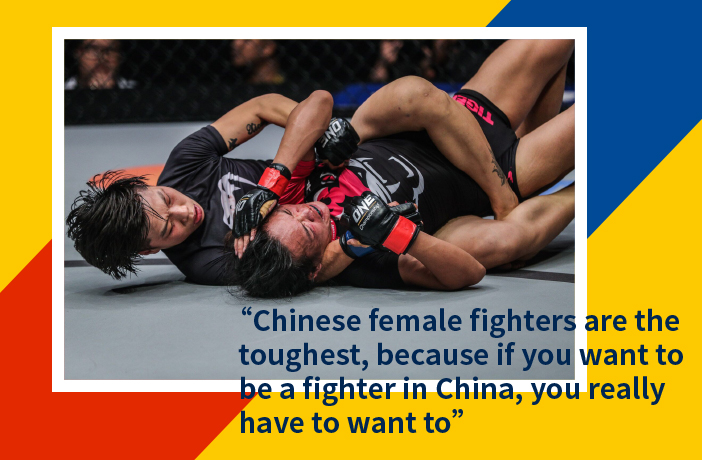
Pro MMA fighter Xiong 'The Panda' Jingnan puts her opponent in a chokehold at the ONE Women’s Strawweight Championship in Jakarta, Indonesia (photo by Dux)
Xiong ties the national flag of China around her neck like a superhero cape as she accepts the title belt, while the commentator booms: “The age of China is upon us.”
MMA, or mixed martial arts, owes its roots to The Ultimate Fighting Championship (UFC), an American MMA organization that pioneered the sport. Beijing-based Jiu-Jiutsu coach Andy Wang grew up in Denver, the city that held the first UFC fight in 1993. “There were no rules, no referee stoppages. It would just be a fight to see what star was the best,” he tells me over lunch. “Now, the UFC is a global brand. Back then, MMA was a curiosity. Now it’s an accepted sport.”
Already popular overseas, the activity has gained traction in China in the past few years, with the number of combat sporting clubs in the country having quadrupled since 2008, the New York Times reports.
Today, international organizations (called ‘promotions’), like Singapore-based ONE Championship, are increasingly visible. UFC held its first mainland event in front of a sold-out crowd in Shanghai last November. Meanwhile, events shown live on CCTV draw up to 20 to 30 million viewers, according to Jetli.com, a kung-fu blog run by the eponymous martial arts star.
A combat sport that uses techniques from a range of wrestling and striking disciplines, like boxing, Taekwondo and Brazilian Jiu-Jitsu, MMA bouts typically last for three 5-minute rounds.
But there’s more to MMA than physical skill – it’s also entertainment. There’s the cage that spectators press up against; the ring card girls, skimpily dressed and generically attractive; the trash-talking and bizarre crossover match-ups (boxer Floyd Mayweather Jr. vs MMA fighter Conor McGregor, anyone?); the over-the-top walkout music and booming voice of the announcer.
Often bloody and always violent, MMA has traditionally been a male-dominated sport. However, awareness of women fighters in the sport is growing, thanks to trailblazers like Americans Ronda Rousey and Gina Carano. In China, fighters like Xiong Jingnan are making their own mark on the scene.

'The Panda' relaxes in her Jiu-jitsu training studio in Beijing
Xiong’s title win has put her name firmly on the radar of those in the industry. I meet the champion and her manager, Libya native Ali Elezzabi, at their training center in Beijing, before she heads home for Chinese New Year. Xiong is nursing a broken hand, suffered in the second round of the title fight. It’ll take another month to heal.
“Every time I had to think twice before using my hand,” Xiong says. “I don’t think anyone can understand how excruciatingly painful it was. But I had to keep focused during the fight.
“I was really excited [leading up to the fight] because I knew that if I won it, then I would be China’s first female fighter to win an international world title.”
The Jakarta bout was Xiong’s second time competing in ONE since she signed a two-year contract with the brand last year (she was previously signed to Chinese promotion Kunlun Fight). Xiong’s contract means that she can fight in ONE events only. The 30-year-old’s first ONE fight was so impressive – she delivered a knockout in the first round – that the outfit promptly offered her a shot at the title.
“She’s like a sponge,” Elezzabi says. “I’ll show her a technique and it’ll take her two or three times to do it. Most people go back to their comfort zone. She’s not afraid to lose, and that’s what makes her evolve.”
Xiong’s success has opened the door to lucrative sponsorships, namely with Gre3n coconut water and AWBR Nutritions Alliance Jiu Jitsu China, both of whom she name drops. The importance of these can’t be overstated, Elezzabi says: “On a monthly basis, her bill can reach RMB10,000 on diet alone.” Although Xiong is from a working-class family in Shandong province, Elezzabi tells me that her family “doesn’t rely on her for support.”

Yet financial reward is a major incentive for many in the sport, Wang says. “A lot of fighters, especially in China, come from bad backgrounds. It’s a way out. You don’t see a lot of rich white dudes, or any [rich] dudes, boxing in America. Here, it’s the same.”
Wang, a former UFC fighter himself, has “seen it all” and doesn’t recommend going pro. “It’s a blood business. You will bleed mentally, emotionally, physically and, for a lot of people, financially.”
But for Xiong, the sacrifice is worth it. “Before the fight, I was training so hard, I could hardly bear it, in my heart and in my mind. [But] the only thing I could see was the belt,” she says. “The belt is every fighter’s dream.”
The Panda may be a warrior in the cage, but, free from training, she lets her guard down. When told to ‘be herself’ during our photoshoot, Xiong bear hugs a punching bag with a huge grin across her face.
Xiong credits her father as the person who’s influenced her the most. “My dad has seen all my fights. He watches them all the time. Sometimes I’ll get a call from him, saying, ‘I watched your fight, and you had a mistake here and here.’
“He always told me to be kind to everyone. I hope [I’ll also] influence others,” Xiong adds. “Especially Asian women.”
Xiong savors her title win (photo by Dux)
Although MMA is growing in China, event lineups are overwhelmingly male, Wang says. “If you go to an event, out of ten fights, only two of them will be women and the rest men.”According to Wang, the number of professional female fighters in China is still relatively small.
“People want to see men because, in the end, what gets people excited [in sports] is violence. And men can produce more violence,” he says matter-of-factly.
Between MMA and kickboxing, Elezzabi estimates about “six or so” professional female fighters in China. (The US, in comparison, has over 100 notable female MMA artists.)
Professional MMA fighters Tian Yang and Meng Bo offer a more generous number. “There’s about 100 professional and amateur women [MMA fighters] in China altogether,” Meng says during my visit to the Beijing apartment she and Tian reside in. “But, really famous ones – around 20.”
And men? “A lot more, about 500, probably,” Tian says. “But not many famous ones. It’s harder for guys because the competition is so good.”
Tian and Meng, both 23, fight together and room together. While neither lay claim to an international title, Meng’s fight record has her ranked No. 5 out of female fighters in China, according to MMA database Tapology (Xiong sits at No. 3). Unlike Xiong, the two are free agents, meaning they aren’t tied to one promotion. Tian has fought for Chinese Kungfu (CKF) while Meng’s most recent fight was for Fight Nights Russia (FNR).
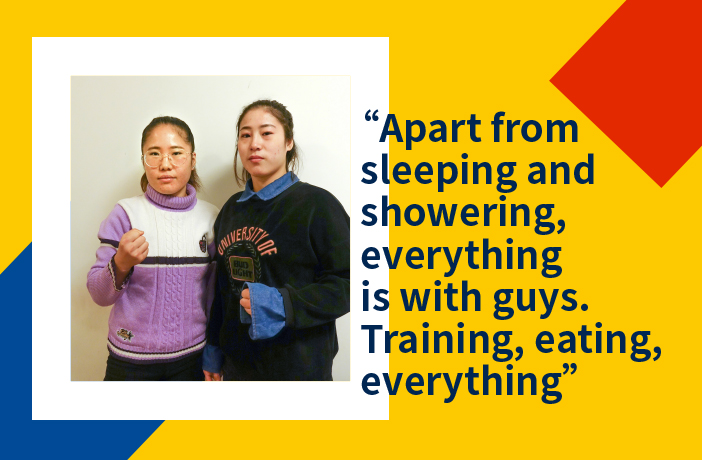
Professional MMA fighters Tian Yang (left) and Meng Bo relax in their apartment
Hailing from Liaoning province in Northeast China, Meng has ten years of combat sport experience. “When I started practicing sanda [Chinese kickboxing], there were only two of us [female fighters]. The other, Wu Yanan, is a UFC fighter now.
“I started practicing MMA in 2012 because I wanted to reach the highest stage in the arena,” Meng continues. “At first, my family was worried. They’d ask me if I got injured or not, but when I continued to persevere, my family grew to support me.”
Sporting glasses and layered up in winter clothes, Tian is relaxed and welcoming – a far sight different to her WeChat profile picture, a commanding shot of her silhouette against a sunset, one leg kicked high in the air, ready to strike.
Originally from Enshi, a prefecture-level city in southwest Hubei province, Tian has practiced combat sports for four years. The Wuhan Sports Institute graduate comes from a fighting background. “My dad used to be a police officer and my uncle a judo fighter.”
Like Meng, Tian says her family was hesitant about their daughter taking up MMA at first, but: “I was very persistent and dedicated, so they eventually had my back. They’re pretty open-minded.”
The fighters train every day with different coaches, depending on their practice, but if they have a fight coming up, it takes them two months to prepare, Meng tells me. In addition to physical training, fighters also have to ‘cut weight,’ to ensure they stay within their designated weight grade.
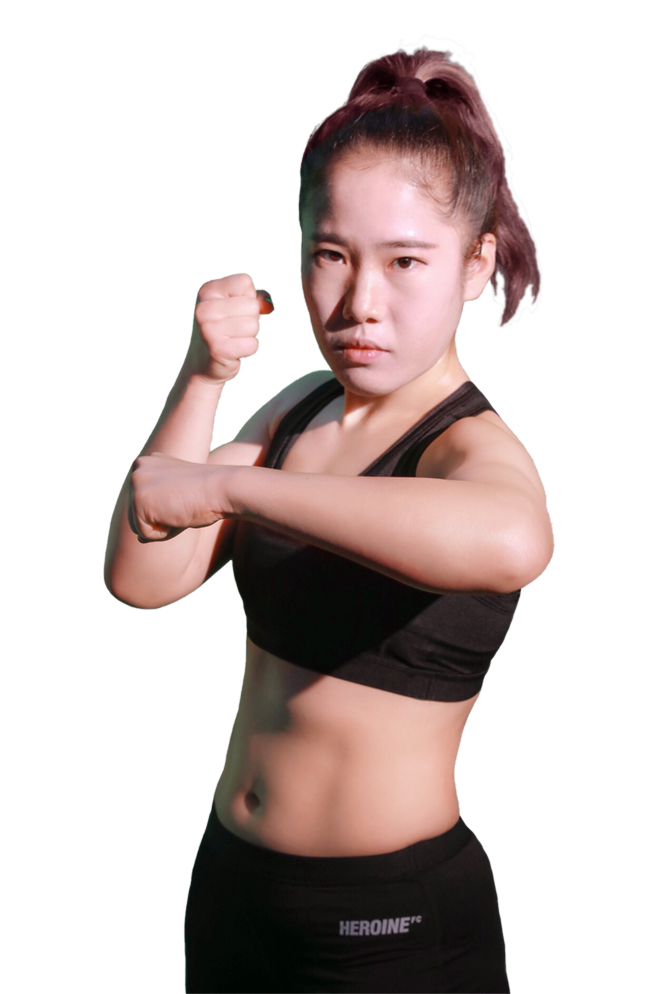
Tian strikes a fighter’s pose
Tian explains: “A lot of Chinese women are uninformed about [combat sports]. They think their body will get bigger and they’ll hurt themselves. To them, MMA is really strenuous. They couldn’t accept this kind of toil, and they wouldn’t be able to bear it, either.”
Due to the limited pool of fighters, women have no choice but to train with men, explains Meng. “Every day you need to practice with guys. Apart from sleeping and showering, everything is with guys. Training, eating, everything.”
The upside of this, according to Tian, is that they “can train with guys that are better [than us] and this will help us improve faster.”
When I ask about whether the industry is sexist, Tian and Yang say no. According to Xiong Jingnan, though, women in the industry are not equal with men.
“Other people’s manner towards female players is different, whether its fans or bosses,” she says. “They even pay women less. It’s the culture [of MMA]. I just train,” she shrugs.
Xiong regularly encounters stereotypes. “My family and close friends accept me, but other people don’t see me as feminine,” she says. “They won’t directly tell me, but will ask, ‘When are you going to get married? When are you going to grow your hair? How long are you expecting to do this for?’”
Even commenters on social media platforms will say she looks like a boy, or a “lady boy,” manager Elezzabi says.
It’s hard to imagine male Chinese fighters receiving the same kind of comments about their looks. For her part, Xiong is nonplussed. “I cut my hair because it got pulled out while practicing Jiu-Jitsu. People can say what they want – I don’t care. I know what I need to do.”
Although Meng prefers to keep a natural look when fighting, she doesn’t like women MMA fighters being put into a box. “Other people don’t have to say anything. At the end of the day, we’re women and we ourselves can keep up our own appearances.”
Yang agrees, saying: “Even though we’re usually busy training, when we have time off, we like to do our hair and that kind of thing.”
Because of numbers – and the added entertainment-value – Tian’s and Yang’s fights are always against foreigners. Yang doesn’t mind – in fact, she hopes that more women fighters from other countries will train in China in the future, because “if they come here, we can learn from each other.”
One such fighter is Yang’s friend, Gita Suharsono, who is also based in Beijing. Over coffee, the Indonesian native tells me she recently transitioned from kickboxing to MMA.
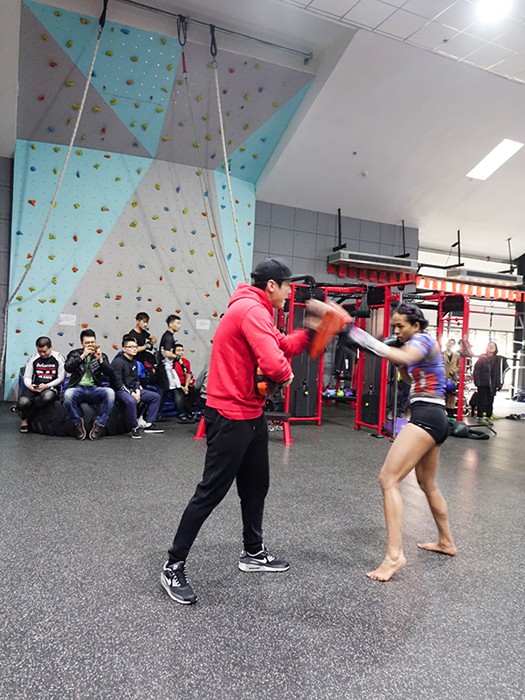
Surharsono spars with her coach before the fight
Tall and lean, Suharsono is a former journalist who, unsatisfied with her lifestyle, quit her job and took up combat sports to get back into shape two-and-a-half years ago. After one fight, she was hooked. “I felt so alive,” she says.
Suharsono trained and has previously fought in Thailand. Although she has won every fight of her career so far, she is especially effusive about her competition in China. “Chinese female fighters are not joking. They are the toughest fights I’ve ever had, because in China, if you want to be a fighter, you really [have to] want to.”
As a foreign female fighter in China, Suharsono is different. “A lot of Chinese women fighters are stockier. They train like that to survive in a male-dominated sport,” she explains. “But you don’t need to be like that – women can be anything. That’s the type of message I want to give.
“I’ve seen a lot of [foreign] fighters just do it for the money [...] but for me the real prize is victory. It tastes so sweet, it’s addictive.”
A few weeks after we meet, Suharsono is accepted to try out for a spot in Rich Franklin’s ONE Warrior Series. A former UFC middleweight champion and now vice-president of ONE Championship, Franklin travels around Asia, from Manila and Seoul to Beijing, to find the next undiscovered superstar fighter from the continent. The ONE Warrior Series is part reality show – in one YouTube episode Franklin’s colleague gets a tattoo in Bangkok – and part “minors to a professional league,” as Franklin describes it. Show participants who are offered contracts are guaranteed four ONE fights.

The Beijing audition takes place in a combat studio in Haidian district on a blustery Sunday. Dozens of wannabe professional fighters wait nervously for Franklin and his team to arrive, while Chinese kids practice sports on the other side of the room. In addition to Suharsono, there is one other woman trying out – Shanghai karate teacher Wang Xue, who has traveled up for the weekend.
Suharsono has a cold. She’s just come back from a training trip in Thailand, she tells me croakily. But, as soon as Franklin arrives, she rushes up to introduce herself and Franklin compliments her top – a Captain America muscle T-shirt.
The two women, the second pair of the day, compete against each other in a series of grappling and striking challenges. Both are impressive. Suharsono, a head taller, is tenacious, all long limbs and fury. Wang is quieter, but grapples well.
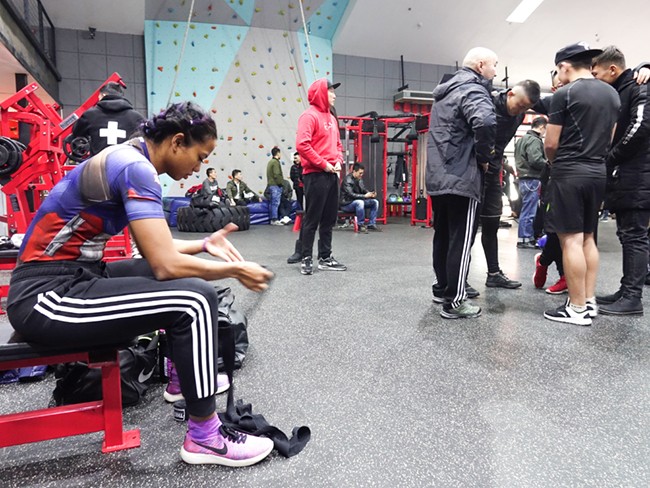
Pro MMA fighter Gita Suharsono prepares for a fight at the ONE Warrior Series tryout
During the event’s lunch break, Franklin tells me he’s noticed an increase in female fighting talent while scouting in Asia. “It’s not just China,” he says, before explaining his surprise at turning up to auditions in Bangkok and Manila to find over half a dozen women trying out.
“I don’t mean it to sound the wrong way, but when we thought about scouting, we kind of automatically thought, subconsciously, that we were going to look for male talent,” Franklin admits.
The former champion puts the rise in female participants in Asia down to natural progression as the sport grows. Plus: “Martial arts are marketed differently here. [MMA] is marketed for things like self-defense, [but] that’s not how is it in the States.”
When it comes down to actual signings for the series, Franklin says he doesn’t follow a quota.
“Hey, Jonathan,” he yells to Jonathan Fong, director of ONE Warrior Series, sitting at the judges’ table a few meters away. “How many females did we sign? Two or three?“
“One,” Fong replies.
“Only one?” Franklin asks, surprised.
“There was one in Manila we were on the fence [about] and we decided to go with her brother instead,” Fong says.
“Oh, that’s right,” Franklin recalls. “OK, so we’ve had one solidly signed female at this point in time. Realistically, to build the sport, I’m probably more interested in finding good quality female talent, than male talent.
“I’ve had a couple [of women] where I’m like, ‘Look, your time in the league is going to be short [at four fights]. So, I want you to work on X, Y and Z, and let’s see you try out again in six months.’”
At the end of the event, both Suharsono and Wang are offered contracts for the ONE Warrior Series. Suharsono accepts. After some consideration, Wang ultimately declines.
The contract offers are a good sign for other China-based female fighters hoping to have a crack at the international professional league.
Meanwhile, back at Tian and Meng’s apartment, the two are adamant that more Chinese women will take up the sport and that the level of Chinese female fighters will improve.
When I comment tentatively that, in the future, perhaps they will have the opportunity to fight against more Chinese women, Meng laughs: “No, a Chinese guy!”
Graphics by Iris Wang





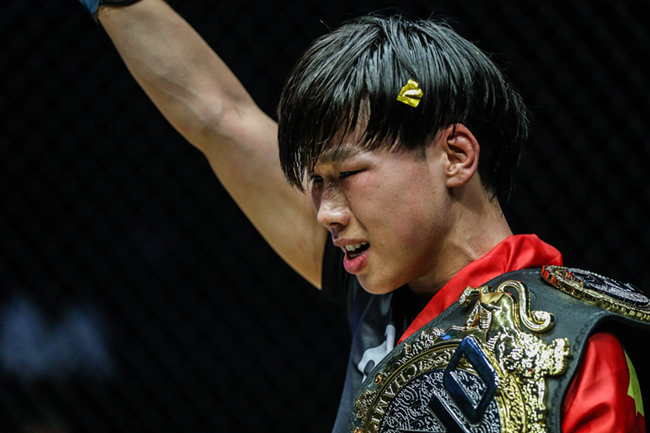
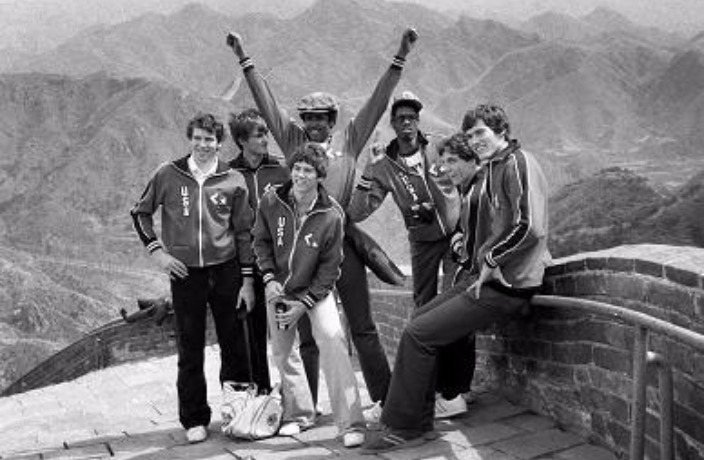
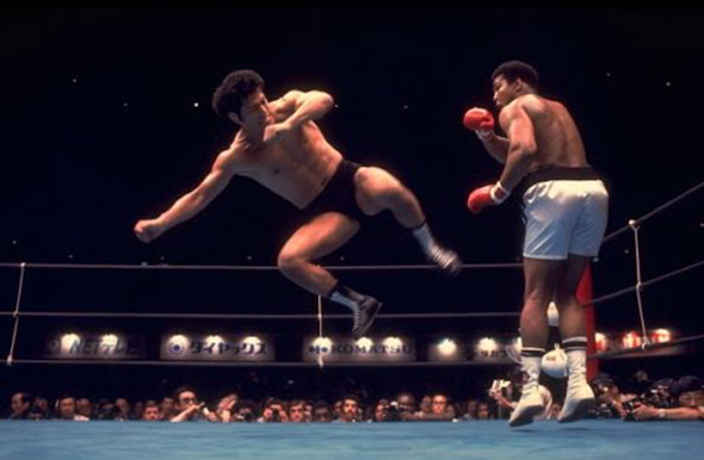















0 User Comments